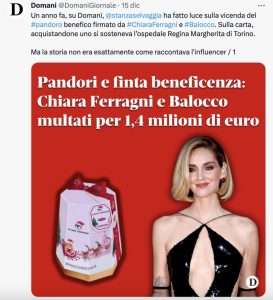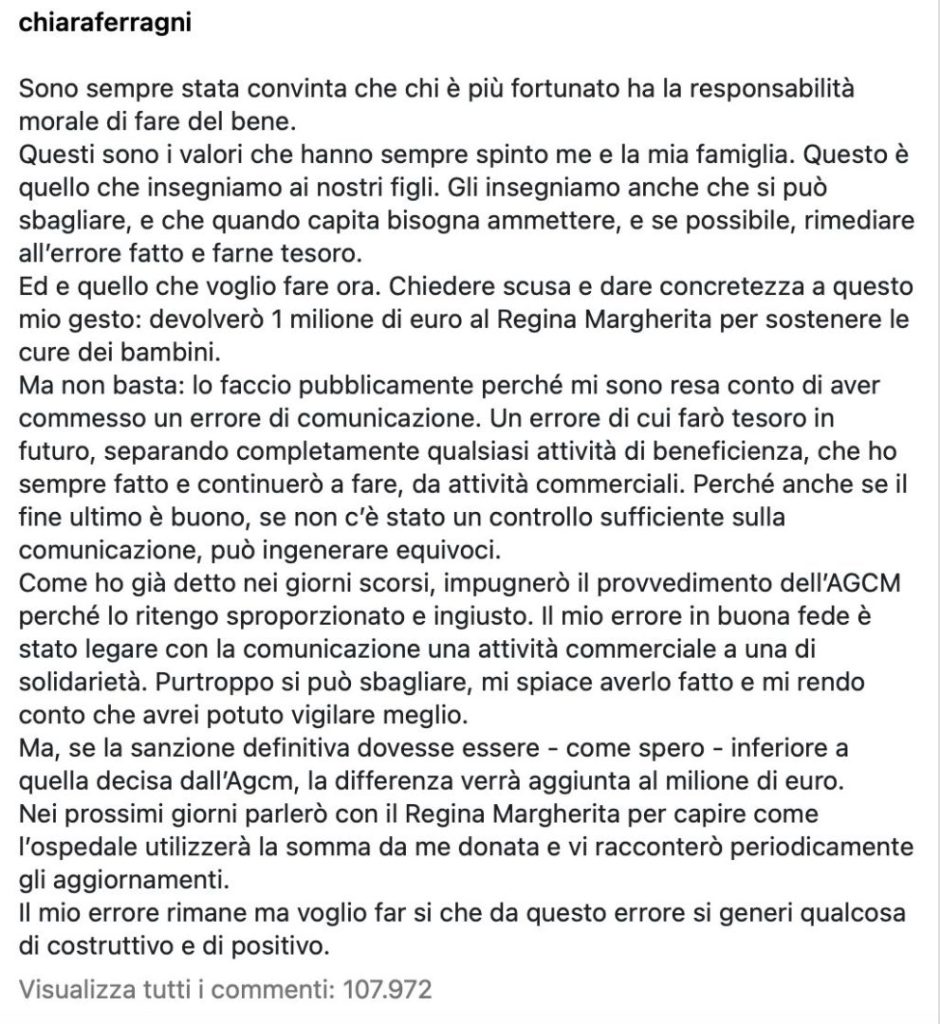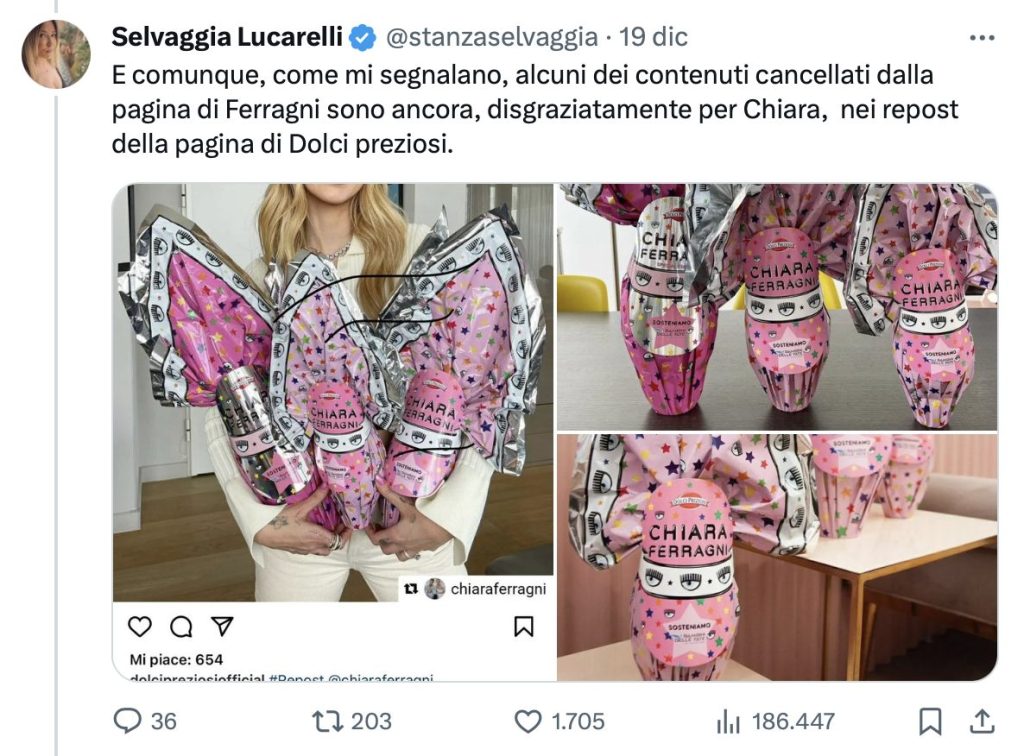Two weeks after the #PandoroGate outbreak, here are my thoughts on the case involving Italy’s best-known influencer and digital entrepreneur.
The facts, in order
To understand this story, we have to go at least as far back as September 2021, when Balocco S.p.A. (confectionery industry), Fenice S.r.l. and TBS Crew S.r.l. (companies that manage the trademarks and rights relating to Chiara Ferragni’s personality and identity) start talking about the initiative to be realised in the following year, which will be called Pandoro Pink Christmas. The contract will be officially signed on 11 November 2021. Already from those first e-mail exchanges it is clear that there will be no correlation between the sales of the pink pandoro and the donation to the Regina Margherita hospital that will take place on 2 May 2022 in the amount of 50,000 euros[1].
In November 2022, a press release was issued to launch the product. The first draft of the press release is proposed by Balocco to the Ferragni team on October 17 via e-mail and in one part says:
“The historical brand from Piedmont, Balocco, recognised and appreciated worldwide for the excellence of its Christmas offer, presents an exclusive novelty created in collaboration with Chiara Ferragni: the Pandoro “#PinkChristmas”. […] With this product, Balocco and Chiara Ferragni are supporting research against childhood tumours, financing a research project promoted by the Regina Margherita Hospital in Turin, through the purchase of a new machine that will allow them to explore new avenues for the therapeutic treatment of children suffering from Osteosarcoma and Ewing’s Sarcoma”.
The Ferragni team responded three days later with the following revision:
“…presents an exclusive novelty: the Chiara Ferragni Pandoro, the sales of which will be used to finance a research project promoted by the Regina Margherita Hospital in Turin, through the purchase of a new machine that will allow new avenues to be explored for the therapeutic treatment of children suffering from Osteosarcoma and Ewing’s Sarcoma”.
On November 2, the revised press release was issued and taken up by almost all local and national newspapers. Since then, the branded pandoro could be found in supermarkets for about 9.37 euros (almost 6 euros more than the classic Balocco pandoro). On the label on each pandoro it is written that “Chiara Ferragni and Balocco support the Regina Margherita hospital in Turin, financing the purchase of a machine that will explore new avenues for the therapeutic treatment of children suffering from Osteosarcoma and Ewing’s Sarcoma”; and Chiara Ferragni herself publishes stories and posts on her Instagram account – with around 30 million followers – where she seems to suggest that the initiative was conceived jointly by her and Balocco for charity purposes. On the contrary, she and her companies did not take part in the donation and were richly remunerated for the operation (collecting more than 1 million euros).
Suspecting the operation is the journalist Selvaggia Lucarelli who, in a report published by Domani on the 15thof December 2022, reveals the lack of transparency of the operation. Between January and April 2023, there were several reports from the Associazione Utenti dei Servizi Radiotelevisivi (a non-profit association founded with the aim of pursuing social solidarity and civil rights protection) complaining about the alleged deceptiveness of the initiative.
On June 14, Balocco was notified of the start of the investigation, which was extended to Fenice and TBS Crew on July 11, 2023. We can therefore state that, at the latest, on July 11 Chiara Ferragni was aware of the ongoing investigation. From that moment on, the Parties exercised their defensive prerogatives on several occasions: Ferragni’s companies, specifically, at the end of July and the end of October, having access to the documents at the beginning of August and mid-October.
As reported in the text of the order, “In their briefs of 28 July and 25 October 2023, Fenice and TBS Crew, in short, represented that the partnership with Balocco was a collaboration of an exclusively commercial nature, aimed at restyling the image of Pandoro Balocco, in order to increase its appeal to a young public attentive to social communications”.
On October 26, the opinion of the Autorità per le garanzie nelle comunicazioni (the Authority for Communications Guarantees, AGCOM) was requested, and on December 15, the Autorità Garante della Concorrenza e del Mercato (the Competition and Market Authority, AGCM) issued a press release announcing the sanction for the companies Fenice and TBS Crew for 400.000 euros and 675.000 euros respectively, and Balocco for 420.000 euros.
As reported in the press release, according to the Antitrust Authority, the promotion of Pandoro Pink Christmas is an unfair commercial practice. In particular, consumers were led into two tricks:
- Assuming a correlation between the sales of the product and the amount donated to charity – to which the press release, the message printed on the scroll attached to each Pandoro and Chiara Ferragni Instagram’s stories and posts contributed – when instead the donation had already been made in May 2022.
- Believing that Chiara Ferragni was contributing to the donation in some form, when instead her companies collected over 1 million euros, without anything being transferred to the Regina Margherita.
In summary, Ferragni and Balocco provided misleading information with respect to the initiative, exploiting consumer awareness of charitable causes to increase sales and justify the cachet demanded by the companies traceable to Ferragni herself. Moreover, in the case of the well-known influencer, there is the aggravating circumstance of having exploited the charity without any real involvement to increase her reputational capital.
In addition to this, as Fanpage reports, “there is also the Codacons complaint for aggravated fraud against consumers (…). In a note, Codacons called for the intervention of the GdF (finance guard) with a request to place its companies accounts under seizure in order to protect the claims of consumers who bought the branded pandoro”.
What happened next we have seen over the past two weeks, and in terms of the development of a crisis it is not surprising, both because it recalls particularly heartfelt values and themes, and because of the popularity of the protagonist of the story and its core business. A sh*t storm followed by the delivery of the tapiro d’oro by Striscia la notizia (a satirical television programme), the threat of revocation of the “Ambrogino d’oro” (a recognition from the municipality of Milan), reminders of previous scandals, such as wasted food at the supermarket, the toast at high altitude in Switzerland, stolen bathrobes and so on. A sort of x-ray of the negative, which lends itself perfectly to being commented on not only by the media, but also by the political world, professionals, haters and Ferragnez[2] fans, as well as by all citizens at the various gatherings of these festivities. After all, when the business is to sell oneself and one is so embedded in people’s daily lives, what else can one expect?
Crisis or no crisis?
This may seem like a trivial question, but in my opinion, it is not, and it allows us to review some elements to define the crisis.
First, we must ask ourselves “for whom” it is a crisis. In this article I will only discuss Chiara Ferragni, although there would be a lot to say about the position of Balocco, which, on the one hand, benefits from the fact that the spotlight is on the influencer and, on the other, knows that precisely because of that influencer it will not be extinguished any time soon.
What is a crisis for an organisation – be it a company, an entity, a person, etc. – is always not determinable in advance and valid, but contextual (and the organisation’s preparedness is also part of the context). If we consider crisis as an ‘existential threat’, we can confidently state that most crisis management interventions for customers are, fortunately, ‘simple’ issue management.
What the organisation is trying to protect in the crisis is its licence to operate, figuratively speaking, and so to understand whether this is a crisis for Chiara Ferragni, we have to ask ourselves what this means for her. And the answer is simple: to suffer such reputational damage as to lose the power of influence and desirability in the eyes of both followers and business partners.
Moreover, in the crisis, the event itself is not the focus. The problem is the impacts that are generated. In this sense, the most significant ones after the AGCM news have been:
- The publication, the day after the apology video (which I will comment later), of a second article by Selvaggia Lucarelli, accusing Ferragni of having adopted the same mechanism of exploiting charity for Easter eggs promoted in collaboration with Dolci Preziosi (Cerealitalia). This has a major impact on the perception of the crisis, turning the #PandoroGate into a mere example of a bigger scam applied in pattern: masking commercial operations in charity concerning children suffering from diseases and the hospitals that treat them. An ethical and moral issue.
- The announcement by Safilo Group in a press release on 21 December that the company was interrupting the licensing agreement for Chiara Ferragni-branded eyewear collection, causing, on the one hand, a further economic loss – in addition to that already deriving from the fine, the donation to “make up for the mistake” and those deriving from the interruption of business as usual – and on the other hand, the fact that Safilo could potentially be the forerunner of a long series of collaborations and projects that are being cancelled.
- The loss of 157 thousand followers from Chiara Ferragni’s Instagram profile in a two-week period, which – as YouTrend reports – while seemingly a high number, actually represents 0.5% of the total, but at the same time also indicates a course that is being traced and, for the first time, is going in the opposite direction.
- The news dated December 27 where it is rumoured that a task force made up of two law firms has been set up to support the Chiara Ferragni ecosystem, testifying to the risks at stake and the need for more resources to support it.
For the Crisis Ready Institute, a crisis is an event that disrupts business as usual; requires immediate escalation to leadership; and threatens a material impact on: people, environment, operations, reputation and/or profits. If we look at all these observations together, the answer is yes, this is a crisis. Which is not to say, however, that now is the time to judge its outcome.
The “make up for the mistake” video and other crisis management mistakes
There are many mistakes in Ferragni’s response to this crisis. And this is surprising. Firstly, because the situation was widely announced. Even assuming she had underestimated any previous alarm bells, as seen from the reconstruction of the facts, at the latest on 11 July 2023 the influencer should have started worrying about the situation. Secondly, because she has a team and can definitely afford the best consultants around. And finally because communication, social networking and the ability to mobilise the network are her bread and butter.
For these reasons, beyond the specific considerations on the “make up for the mistake” video, I think that the biggest fault she is paying for, and for which this crisis could have been ‘only’ a case of issue management if taken in time, is precisely the absence of an anticipatory logic, which is a cornerstone of crisis management. Arriving unprepared, without a crisis communication strategy and in panic, or in any case with little control over the situation, led Ferragni to make mistakes that with more serenity I find it hard to believe she would have made.
After an initial comment to say that she would have appealed the AGCM’s decision only because it was ‘disproportionate’, without further explaining her reasons, on December 18, the fourth day after the news of the #PandoroGate – a very long time compared to what it takes for public opinion to formulate judgements – Ferragni published a video on her Instagram profile. The choice of the channel is appropriate because it is her natural place, but she addresses only a part of the stakeholders in the affair.
The ‘make up for the mistake’ video – which you can find here – has been criticised and commented on far and wide, especially for the non-verbal communication part – from the choice of outfit, to the choice of sober make-up, to the tears described by many as ‘crocodile-like’. And even in terms of verbal content, it was not convincing.
The impression I got from seeing it the first time was a bit like when you’re about to be quizzed at school and you haven’t prepared, but you have a friend handing you his notes from the “Crisis Communication for dummies”, so you memorise those three or four things to say or do, but you haven’t understood them on a deeper level.
In fact, Ferragni starts off by bringing up values, which are the fundamental compass to orient yourself in crisis management, and reiterates in several passages the wish to learn from the mistake, as can be seen in the image showing the full text of the post (translated in note)[3].
The problems, however, arrive early and can be summarised as a lack of transparency; a lack of credible and incomplete narrative; the omission of responses to the legitimate expectations of followers; a general difficulty in recognising the problem, reading the situation and understanding the implications of one’s communication actions.
The ABC of a proper crisis communication strategy would say: show seriousness, recognise the problem, recognise the stakeholders. The last two are particularly missing here.
If we wanted to reduce the whole case to one question, that would be: Is Chiara worthy of our trust?
We move into the territory of perceptions, and it is conceivable to imagine that her followers – neutral or lovers– may have experienced emotions associated with betrayal and/or disappointment. And, therefore, they expect explanations and clarifications, as well as a sincere apology and a commitment to try to remedy where possible.
When analysing a response from the perspective of crisis communication, we need to focus as much on what is present as on what is missing.
In Ferragni’s video, there is no reference to the events that took place before the publication of the AGCM press release on December 15; no direct statement of what the problem is – deception and taking advantage of the charity cause – and no explanation of the choice of keeping silent and not trying to remedy the situation until the fuss became public.
And so it jumps a little too quickly to the desire to patch the hole, choosing – copying an expression read these days – a patch that is worse than the hole itself.
As a famous Italian advertisement reminds us, there are things that cannot be bought, and trust and forgiveness are among them. The solution of making up by donating 1 million euros to the Regina Margherita hospital leads one to question what is the assumption behind her choice and to shift the perception no longer on the case but on the identity values of her person. Does Chiara really think that by paying, mistakes will be fixed and a new start will be made? And that donating 1 million will make those who spent those 9 euros by choice, thinking they were going to charity, forget the deception?
And if this was not enough, things get even worse, in an attempt to apply a frame – to frame and interpret the event – that might be credible for others, but cannot work for the Queen of social networks: “the communication mistake”. A weak and false frame, but one that she firmly expresses and reiterates that she will treasure in the future by “completely separating any charity work, which I have always done and will continue to do, from commercial activities. Because even if the ultimate goal is good, if there has not been sufficient control over communication, it can generate misunderstandings (…) My mistake in good faith was to link a commercial activity and one of solidarity with communication”.
As Selvaggia Lucarelli also said, the problem is not the charity through the sale of a product, but the fact of having presented herself in front of 30 million followers as an active part of a project, when she was neither offering her image for free for charity – in the e-mail exchanges Balocco’s team ironically jokes about the fact that the increased price of the product is necessary to pay her cachet – nor had she donated to support that cause.
Finally, she reiterates her willingness to contest the AGCM order, saying that if the fine is reduced, the difference will be donated to the hospital. A provocative attitude towards the authority as opposed to a more classic approach of declaring oneself collaborative and transparent. She concludes by promising periodic updates on her donation, which we have not yet received, whereas in such cases it would be appropriate to indicate when an update will be provided even in the absence of news, and emphasising again her wish that something positive and constructive be generated from this error.
Final thoughts
There have been many mistakes, some really rough – such as the removal of past posts relating to the sale of Easter eggs, among other things still present in Dolci Preziosi’s accounts – in this crisis management. At the level of communication, the most obvious is the total absence of a strategy, a shortcoming that will not be resolved by a task force composed of two law firms, which have a different focus and should work in synergy with crisis communication experts.
However, her fate is not yet definitely decided. She has a previous reputation in other solidarity spheres that, if no other scandals emerge, could work in her favour, and still a network of supporters who are willing to welcome her back. The possibility of working on a long recovery phase once the situation has stabilised is real.
If I were to intervene now without having had the chance to do so before, before working out any strategy, perhaps what I would say to Chiara Ferragni would be to look at that tattoo on her hand and start from there. Which is the Chiara I would like?
Author: Irene Proto (@crisis_with_irene)
If you liked this article, you might also want to read this one.
[1] To read the text of the mesure (Italian only) follow this link: https://www.agcm.it/dotcmsdoc/allegati-news/PS12506%20chiusura.pdf.
[2] ‘Ferragnez’ is the nickname given to the married couple Chiara Ferragni and Fedez.
[3] “I have always been convinced that those who are more lucky have a moral responsibility to do good. These are the values that have always driven me and my family. This is what we teach our children. We also teach that you can make mistakes, and that when it happens you have to admit it, and if possible, make up for the mistake made and treasure it. And that is what I want to do now. Apologise and give substance to my gesture: I will donate EUR 1 million to the Regina Margherita to support children’s treatment. But this is not enough: I am doing it publicly because I realised I had made a communication mistake. A mistake I will treasure in the future, completely separating any charitable activity, which I have always done and will continue to do, from commercial activities. Because even if the ultimate goal is good, if there has not been sufficient control over communication, it can lead to misunderstandings.
As I have already said in recent days, I will challenge the AGCM’s measure, because I consider it disproportionate and unjust. My mistake in good faith was to link a commercial and solidarity activity with the communication. Unfortunately one can make mistakes, I am sorry I did, and I realise I could have been more vigilant. But, if the final sanction should be – as I hope – lower than the one decided by the Agcm, the difference will be added to the million euro. In the coming days I will talk to the Regina Margherita to understand how the hospital will use the sum I donated and I will periodically give you updates. My mistake remains, but I want to ensure that something constructive and positive is generated from this mistake”.









